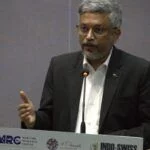- Routine underwater commercial activities are being targeted and weaponised, increasing vulnerabilities to critical national infrastructure. Against this backdrop, the importance of Underwater Domain Awareness (UDA) need not be overstated.
- It studies the scope of increasingly vulnerable maritime infrastructure like oil and gas pipelines, electricity grids, and underwater communication networks that have emerged as the new frontlines of potential conflict.
- Commercial offshore infrastructure like undersea internet cables, power cables and oil and gas pipelines have become potential targets.
- States increasingly depend on infrastructure and assets partially or completely located outside their jurisdiction and over which they have little or no control. Most of the critical infrastructure is owned by the private sector.
- India is barely present in undersea fibre-optic cables despite being one of the world’s largest telecom and data markets and having the world’s second-largest digitised citizenry (after China).
- The National Security Advisors of India and the US launched the initiative on Critical and Emerging Technologies (iCET) on 01 February 2023, which promises to foster an open, accessible, secure technology ecosystem.
- India-US iCET has opened opportunities to develop an innovation bridge for cutting-edge commercial technologies in artificial intelligence, quantum technologies, advanced wireless, jet engines, munition-related technologies, maritime security and intelligence surveillance reconnaissance (ISR), space, and resilient semiconductor value chains.
- One of the main uses of subsea technology is for offshore drilling and cable laying. Indigenised technologies produced by the DRDO or NIOT have neither been commercialised nor have been inducted into defence.
- In the digital domain, insertion of foreign technologies is inexorable and omnipresent. There is a need to reduce vulnerabilities to external influence and dependencies as a potential security threat by harnessing control over key critical technologies and infrastructures.
- The advantages of underwater commercial warfare are their deniability and the ability to disrupt the opponent economically before or during a war.
- The modern trends of warfare and sabotage have re-kindled the importance of Underwater Domain Awareness (UDA) after the Cold War.
- While maritime security and cybersecurity are the most notable policy fields for underwater security, a broader policy understanding is essential for a more comprehensive security of Commercial Offshore Infrastructure Systems (COIS). It will need ocean governance, digital policy and external action.
Introduction
One of the goals of India’s ‘Atmanirbhar Bharat’ launched by Hon’ble Raksha Mantri in September 2022 is Civil-Military Fusion (CMF). The concerted effort by the Ministry of Defence (MoD) has not just increased the indigenous components of defence acquisition, but India’s defence exports have reached an all-time high of ₹15,920 crore in FY 2022-23. Indian Navy’s consistent endeavour has been appreciated by Hon’ble Prime Minister during the recent ‘Swavlamban’ Seminar. However, changes in the nature and character of warfare have forced all countries to revisit their maritime defence strategies. Sabotage, grey-zone conflict, and asymmetric warfare are altering the balance of threat, even when the balance of power between countries remains relatively unchanged. Routine underwater commercial activities are being targeted and weaponised, increasing vulnerabilities to critical national infrastructure. Against this backdrop, the importance of Underwater Domain Awareness (UDA) need not be overstated. However, the mere absorption of advanced underwater technologies would be inadequate for optimal defence for critical underwater national assets, constituting an effective deterrence, or conducting an offensive/covert action against an adversary. There will be a need to synthesise the existing Organisations, Innovations, and Logistics, or the OIL of CMF for enhancing the UDA.
This paper seeks to examine the application of CMF in UDA. It studies the scope of increasingly vulnerable maritime infrastructure like oil and gas pipelines, electricity grids, and underwater communication networks that have emerged as the new frontlines of potential conflict. In addition, it identifies the possible vulnerabilities of adversaries in the immediate neighbourhood. The paper further explores the increased weaponisation of liminal technologies that could morph UDA from the benign realms of Science and Technology (S&T) to geopolitical and strategic contestation for monopoly in the years ahead. Therefore, the National Security Council will also have to identify new technologies requiring collaboration under the India-US Initiative on Critical and Emerging Technologies (iCET) in UDA domain. Finally, the paper suggests for enhancing India’s maritime security, minor structural changes that would be necessary by synthesising Organisations, such as International Fusion Centre – Indian Ocean Region (IFC-IOR), The Coast Guard, National Institute of Ocean Technology (NIOT), Ministry of Petroleum and Natural Gas (MoPNG), Ministry of Communications (MoC), and Ministry of Electronics & Information Technology (MoEIT).

Commodore (Dr.) Somen Banerjee (Retd.)
About Author
Commodore (Dr.) Somen Banerjee (Retd.) is an Anti-Submarine Warfare specialist and has commanded three worships of the Indian Navy. He has served as Senior Fellow at the Vivekananda International Foundation (VIF), and the National Maritime Foundation (NMF) in Delhi. As an academic, he conceived and executed the idea of India joining the Indian Ocean Commission and the Djibouti Code of Conduct as an Observer.
He has authored two books – Maritime Power through Blue Economy and Sea of Collective Destiny: Bay of Bengal and BIMSTEC, published papers in Taylor & Francis, SAGE, and IFAJ, and written several issue briefs and commentaries. His recent paper, entitled Civil- Military Fusion, was published by CENJOWS in March 2023.
He is a MSc form the Madras University and a MPhil, PhD from Mumbai University in Defence and Strategic Studies.


